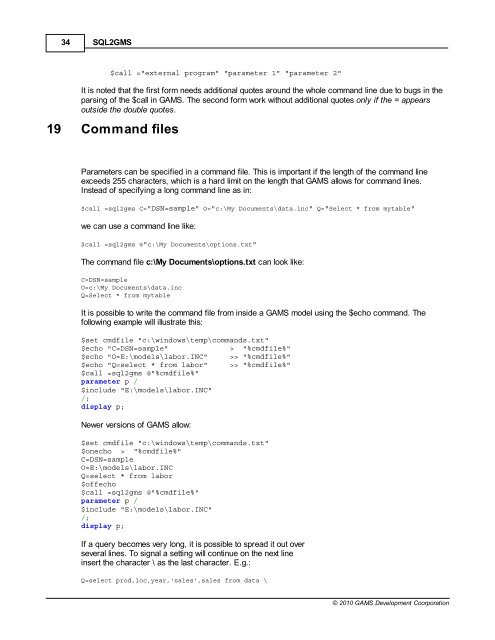SQL2GMS - GAMS
SQL2GMS - GAMS
SQL2GMS - GAMS
You also want an ePaper? Increase the reach of your titles
YUMPU automatically turns print PDFs into web optimized ePapers that Google loves.
34<br />
<strong>SQL2GMS</strong><br />
$call ="external program" "parameter 1" "parameter 2"<br />
It is noted that the first form needs additional quotes around the whole command line due to bugs in the<br />
parsing of the $call in <strong>GAMS</strong>. The second form work without additional quotes only if the = appears<br />
outside the double quotes.<br />
19 Command files<br />
Parameters can be specified in a command file. This is important if the length of the command line<br />
exceeds 255 characters, which is a hard limit on the length that <strong>GAMS</strong> allows for command lines.<br />
Instead of specifying a long command line as in:<br />
$call =sql2gms C="DSN=sample" O="c:\My Documents\data.inc" Q="Select * from mytable"<br />
we can use a command line like:<br />
$call =sql2gms @"c:\My Documents\options.txt"<br />
The command file c:\My Documents\options.txt can look like:<br />
C=DSN=sample<br />
O=c:\My Documents\data.inc<br />
Q=Select * from mytable<br />
It is possible to write the command file from inside a <strong>GAMS</strong> model using the $echo command. The<br />
following example will illustrate this:<br />
$set cmdfile "c:\windows\temp\commands.txt"<br />
$echo "C=DSN=sample" > "%cmdfile%"<br />
$echo "O=E:\models\labor.INC" >> "%cmdfile%"<br />
$echo "Q=select * from labor" >> "%cmdfile%"<br />
$call =sql2gms @"%cmdfile%"<br />
parameter p /<br />
$include "E:\models\labor.INC"<br />
/;<br />
display p;<br />
Newer versions of <strong>GAMS</strong> allow:<br />
$set cmdfile "c:\windows\temp\commands.txt"<br />
$onecho > "%cmdfile%"<br />
C=DSN=sample<br />
O=E:\models\labor.INC<br />
Q=select * from labor<br />
$offecho<br />
$call =sql2gms @"%cmdfile%"<br />
parameter p /<br />
$include "E:\models\labor.INC"<br />
/;<br />
display p;<br />
If a query becomes very long, it is possible to spread it out over<br />
several lines. To signal a setting will continue on the next line<br />
insert the character \ as the last character. E.g.:<br />
Q=select prod,loc,year,'sales',sales from data \<br />
© 2010 <strong>GAMS</strong> Development Coorporation

















